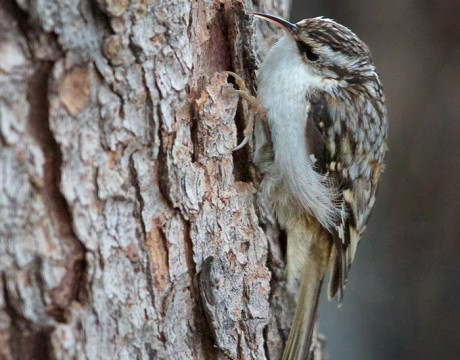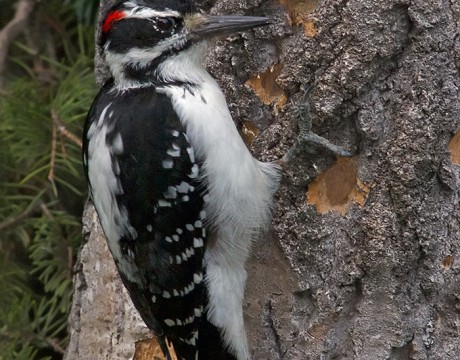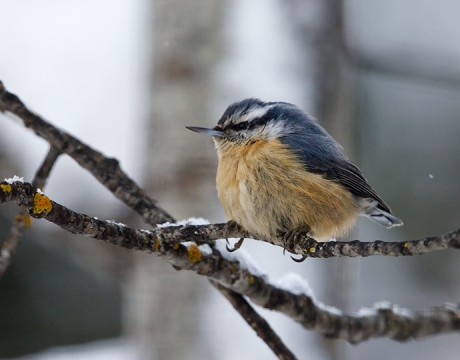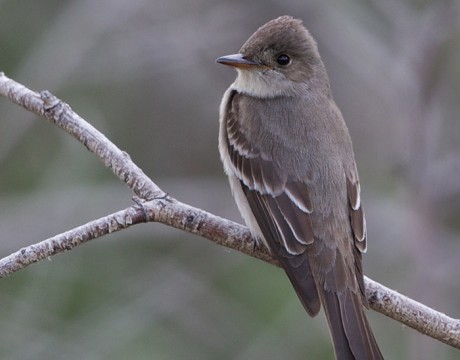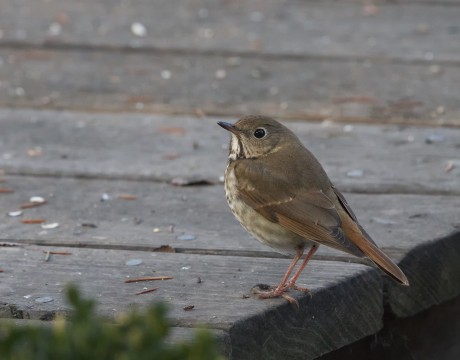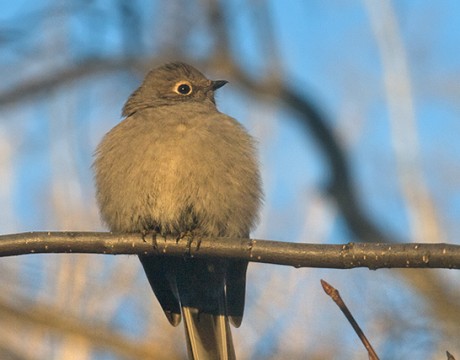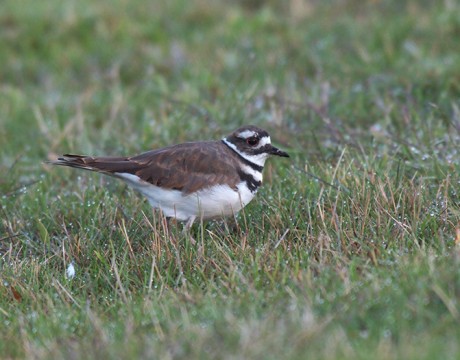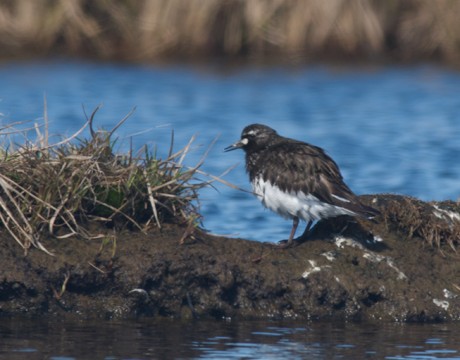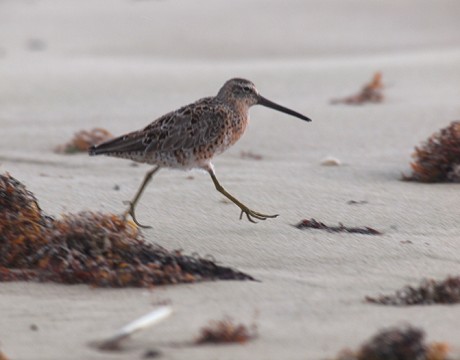Bird of the Week – Brown Creeper
If December 17’s Red-breasted Nuthatches usually climb down trees, Brown Creepers usually climb up. The cryptic coloration and very high-pitched vocalization on this species can make it tough to find. And populations have been greatly reduced by clear-cutting and removal of dead and dying trees, its preferred foraging area. The creeper uses its slender, decurved bill to capture invertebrates—mainly insects, spiders, and pseudoscorpions—from furrows in tree bark. It was not until 1879 that ornithologists discovered Brown Creeper’s unique habit of building a hammock-like nest behind a loosened flap of bark on a dead or dying tree. Those nests are incredibly hard to find. For more…
Bird of the Week – Hairy Woodpecker
For Christmas Eve, we’ll have a bird with a splash of Christmas color, the male Hairy Woodpecker. Only the males have red on their heads; females are just black and white. The Hairy Woodpecker is Alaska’s largest woodpecker. They are sometimes difficult to find in the forest. Tracking them down by their drumming is the usual approach. But they are enthusiastic about suet feeders, especially in the interior. Hairys dig nest cavities in trees. Looks for piles of wood chips around the base of a tree. Once the eggs hatch, the kids are noisy and the nest is pretty easy…
Bird of the Week – Red-breasted Nuthatch
You usually hear the characteristic “tinhorn” yank yank call of the Red-breasted Nuthatch before you see the bird. This species famously climbs head downward on tree trunks, distinguishing itself from the much-drabber Brown Creeper, which climbs up. The species is found across the United States and Canada, wherever there are spruce of fir trees, its preferred habitat. In Alaska, it’s common in southcentral and southeast, but uncommon in the interior and accidental further north and west. Unlike chickadees, Red-breasted Nuthatches rarely use nest boxes or existing cavities. In the winter, they join mixed flocks to forage, and are enthusiastic visitors to birdfeeders….
Bird of the Week – Chestnut-backed Chickadee
This is a colorful cousin to the more common and familiar Black-capped Chickadee. This is a bird of the far west and southeast and southcentral Alaska. While it is less vocal than its cousins, like Black-capped and Boreal Chickadees, it nests in cavities and readily uses nest boxes. During winter, they forage in mixed-species flocks with other chickadees, primarily Black-capped and Mountain Chickadees, as well as other small birds such as Ruby-crowned Kinglets and Red-breasted Nuthatches. For more bird photos, please visit Frozen Feather Images.
Bird of the Week – Western Wood-Pewee
There are three species in this genus this small flycatchers, but only one, the Western Wood-Pewee, is commonly found in Alaska. This is a small, drab bird, but the slight crest, indistinct or missing eye ring and whitish belly and throat make it fairly easy to identify in field. At least is you are outside the range of Eastern Wood Pewees, and happily, in Alaska we are. Fairbanks is near the northerly limit of the species’ documented breeding range. They winter in Central and northern South America. Any bird that eats mosquitoes is a winner, in WC’s thinking. Which makes the…
Bird of the Week – Hermit Thrush
There’s one more thrush that breeds in Alaska. The Hermit Thrush. The species is pretty common in spring and summer boreal forest under stories, usually in drier and brushier areas. Note the complete white eye ring, spotted breast and reddish tail and flanks. Hermit Thrushes are best known for their song, an ethereal fluting, with a long note followed by two or three higher, fading trills. It’s haunting and lovely, and often goes on all night during courtship. It’s WC’s favorite bird song of the boreal forest. For more bird photos, please visit Frozen Feather Images.
Bird of the Week – Townsend’s Solitaire
In the winter of 2008, WC and Mrs. WC were lucky enough to have a Townsend’s Solitaire hang around their bird feeders most of the winter. That’s uncommon. Solitaires don’t usually visit feeders, and usually migrate south to the Lower 48 during the winter. A drab, gray bird with a strong white eye-ring and a small buffy patch on its flank, the Solitaire breeds in the mountains, near or even above tree line. The species isn’t well studied in its breeding range. But in spring, the male’s song is a beautiful keynote to the season. Praised as “one of the…
Bird of the Week – Killdeer
Killdeer, a species of plover, are uncommon in Alaska. Famous for the call that gives them their name and their remarkable broken-wing display they use to lead you away from the nest, are North America’s most common plover. Fairbanks is at or near the northernmost edge of their usual range. But Killdeer are present in low numbers year-round in Southeast Alaska. Unlike their smaller cousins, Semipalmated Plovers, Killdeer habituate to human activity and are common in parks, golf courses and sports fields. For more bird photos, please visit Frozen Feather Images.
Bird of the Week – Black Turnstone
The Black Turnstone is the drabber cousin of last week’s Ruddy Turnstone. The Black Turnstone is a North American bird, breeding only on the western shore of Alaska. It winters along the Pacific coast, as far north as Kodiak Island and as far south as Baja California. This little 9.25 inch bird is about as belligerent as a shorebird gets. WC has watched them attack a Long-tailed Jaeger, a bird four times its size, screeching defiance the whole time. Unlike other shorebirds, presented with a threat, even an innocent photographer, a Black Turnstone runs directly at the threat, in a hunched-over…
Bird of the Week – Short-billed Dowitcher
WC overlooked the Short-billed Dowitcher when posting its close cousin, the Long-billed Dowitcher, back in August 2015. It can be pretty tough to tell a Long-billed from a Short-billed. Location helps: if you are on the coast, it’s more likely a Short-billed; if you are further from the ocean, it’s more likely a Long-billed. Bill length and coloration vary a lot. The calls are different, but both Dowitchers spend most of their time in a frenzied feeding, their bills probed full length in the mud, like a busy sewing machine. Dowtichers are not well-studied. Even their name is a puzzle….





